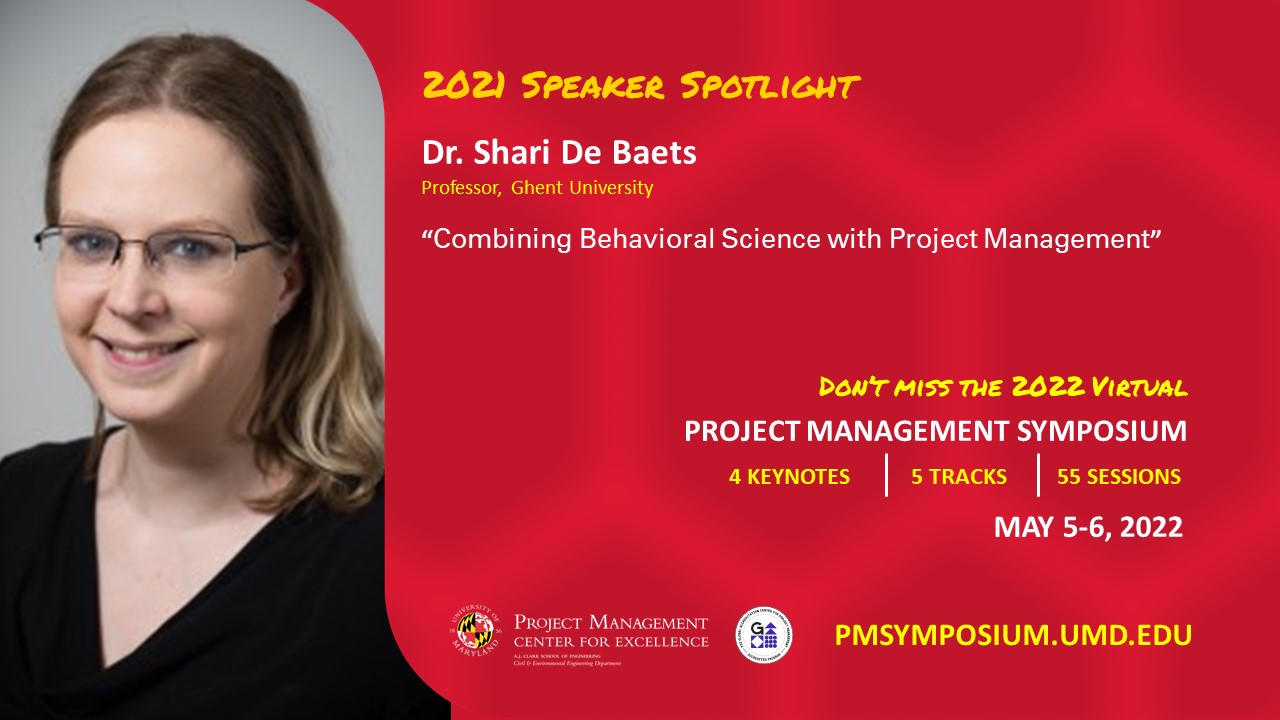In our 2020 Project Management Symposium at the University of Maryland, we launched the idea of having one of our featured speakers present on how brain functioning impacts the management of projects, and we featured Josh Ramirez[1] speaking on “Redesigning Project Management Around the Brain”. In the 2021 Symposium, Dr. Shari De Baets[2] delighted the audience sharing insights from her research on the intersection of behavioral science and project management “Combining Behavioral Science with Project Management: The Road to Improvement”. This article is a summary of the highlights of her presentation.
People want to do their jobs well. They want to work in cooperative, engaging teams, and build good products. But project managers generally consider projects to be successful only when they are completed within boundaries of scope, time, cost and quality. Sometimes, they succeed. More often, they fail. Why? Because traditional project management methods have scarcely acknowledged the true impact of human experience and behavior on the outcome of a project.
The strategic decisions involved in project management can make or break a company; yet most business leaders would admit the quality of their decisions are far from perfect. Understanding what propels people’s behavior is among the key factors that drive successful project management—and it is a factor many project managers need to consider much more as they determine how best to deliver top results in an environment that is often complex, volatile, and uncertain.
Along the way, we have all learned about the brain’s fight-or-flight response to physical stressors. But we are not nearly as familiar with the idea that our brain responds acutely to social stressors—like the ones we find in our workplace—in the same way. Dr. De Baets’s research indicates that re-evaluating and revising decisions to account for how the brain actually operates will make the difference between project failure and success.
The brain is pretty amazing, but it still has limitations. She talks about introducing metrics that can take human factors into account, instead of just measuring hard data. According to Dr. De Baets research, we need to design our interfaces around how people think, make it easier for people to make decisions, and train employees in how to handle cognitive errors.
So, how can behavioral science be applied to making project managers better?
Dr. De Baets says to start by rethinking your approach to the project. Economic models that project managers have traditionally studied assume that everyone behaves rationally and that when people make a decision, they’ll make it based on “usefulness times probability.” Research indicates this is not the case.
But humans are not robots. That is why when standard decision-making models are applied to project management, the results are often dismal. The presupposition is, people always use logic to make decisions, so they will choose the methods that will perform best. Yet, people do not make decisions based on rational behavior—they react based on many complex factors, including their own gut feelings, often very optimistic!
The research supports a paradigm shift toward the belief that classic economic models are not as effective as we thought. Relying on computer-generated data is not enough, although calculations are certainly necessary, but decisions are abstract. Processing and outputting are the most important functions of our brain, but they can be influenced by erroneous beliefs or limited information.
Next, study behavioral forecasting. It is a more complex, but more accurate way to reduce the size of the error. It’s well documented in project management literature that process models and guidelines help people execute a project, but success and failure lies in whether people can recognize their cognitive biases and make decisions based on analysis and estimation. Perhaps other factors play an even more significant role.
Behavioral economics, which includes behavioral forecasting, leads to better results. It’s no longer about executing “rational” decisions to move the project forward. Project managers should start asking themselves how personal experience affects the circumstances at hand. As the reliance on archaic economic models fades, the tenets of behavioral project management make more sense.
Last, Dr. DeBaets cites the research of two Nobel Prize-winning economists, Dr. Herbert A. Simon, and Dr. Daniel Kahneman, who also authored the seminal book, “Thinking, Fast and Slow,[3]” as pivotal in the field of behavioral economics. The thesis of Kahneman’s book is that of a dichotomy between the two modes of thought: A “System 1,” which is fast, instinctive, and reflexive; and a “System 2,” which is much slower, more deliberative and logical.
Especially important to Kahneman and Simon’s discussions, according to Dr. De Baets, are “heuristics,” which are mental shortcuts, or biases, that provide us with fast, cognitive reactions. The problem is, we use these “mental shortcuts” in situations we shouldn’t, because it may introduce a cognitive bias.
Heuristics aren’t to be confused with a racial or gender bias or prejudice—these are reasoning errors that cause you to go against what is logical—the exact errors that can result in fatal flaws in the project.
The first step to integrating behavioral science into project management is simply to acknowledge that these heuristics exist and then applying countermeasures. Dr. De Baets suggests learning about the three categories of biases—cognitive, group and memory. There are so many of them, including the one that plagues so many projects—optimism bias. That means we plan unrealistically, believing we’ll finish sooner, we’ll need fewer resources and the project will cost less, therefore the profit margin will be wider.
To counter this, Dr. De Baets recommends task segmentation and a complete “unpacking” of each activity and sub-activity. Doing a separate analysis and activity estimation generally results in people believing too much time has been planned, but actually, it’s more realistic, and it’s the first step on the path toward addressing the optimism bias.
So, perhaps it’s time for the profession of project management to evolve toward the next level—project professionals of all specializations should look to a new phase in project management that designs project management processes around behavioral science and focuses on behavioral factors.
Along with her colleague, Josh Ramirez, who is founder and president of the Institute for Neuro and Behavioral Management Project, Dr. De Baets says it is not enough to know these issues exist. To improve the chances for successful project management outcomes, the concepts need to be applied. Josh Ramirez was a featured speaker at the University of Maryland’s 2020 Project Management Symposium, and together, at the NBPM Institute, they are teaching project managers across all organizations to create new practices that will implement more flexible approaches to change and ultimately, better outcomes.
You can watch Dr. Shari De Baets’ full presentation from the 2021 Project Management Symposium. You can also watch Josh Ramirez’s presentation, Redesigning Project Management Around the Brian, from the 2020 Project Management Symposium.
If you are interested in presentations like this, check out the University of Maryland’s VIRTUAL Project Management Symposium to be held May 5-6, 2022. The event will feature 4 keynote speakers and 55 individual sessions in 5 concurrent tracks. More information can be found at the 2022 Virtual Project Management Symposium website.
Register for the 2022 Virtual Project Management Symposium Today
[1] Founder & President, Institute for Neuro & Behavioral Project Management
[2] Ghent University, Faculty of Economics & Business Administration
[3] Thinking Fast and Slow by Daniel Kahneman published in 2011 by Farrar, Straus, and Giroux ISBN 978-0374275631
Posted by Kathy Frankle on July 7, 2021

 Data Analytics for the Project Manager
Data Analytics for the Project Manager
